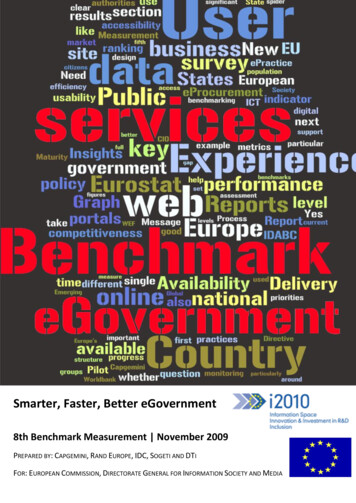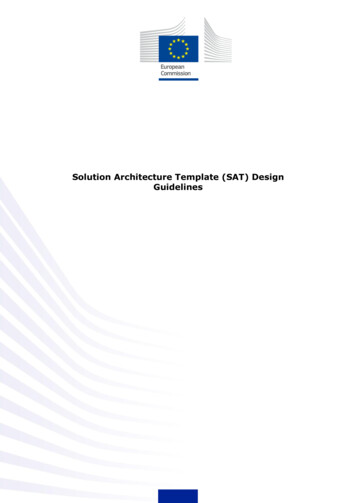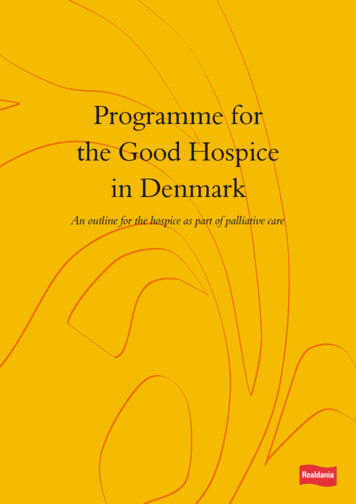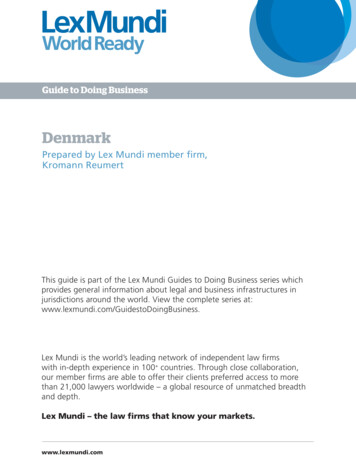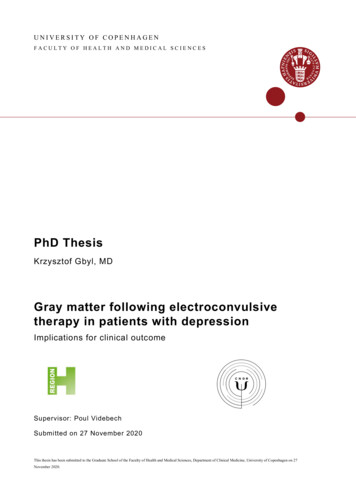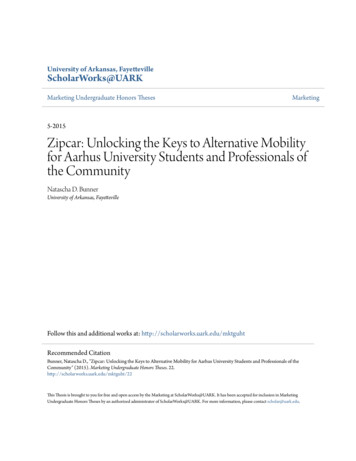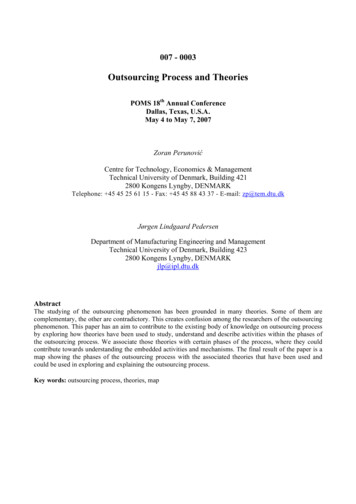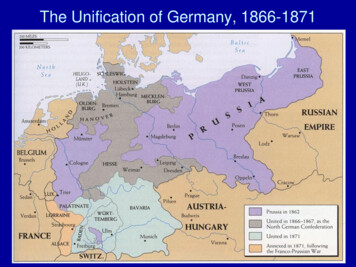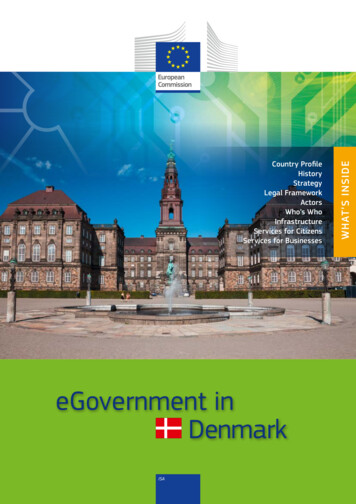
Transcription
eGovernment inDenmarkISAWHAT’S INSIDECountry ProfileHistoryStrategyLegal FrameworkActorsWho’s WhoInfrastructureServices for CitizensServices for Businesses
Visit the e-Government factsheets online on Joinup.euJoinup is a collaborative platform created by the European Commission under the InteroperabilitySolutions for Public Administrations (ISA) in Europe Programme. Joinup provides numerous servicesaround 3 main functionalities:1. An observatory on interoperability, e-government, e-inclusion and e-health2. A collaborative platform of open communities3. A repository of interoperability solutionsThis document is meant to present an overview of the eGoverment status in this country and not to be exhaustive in itsreferences and analysis. Even though every possible care has been taken by the authors to refer to and use valid datafrom authentic sources, the European Commission does not guarantee the accuracy of the included information, nor doesit accept any responsibility for any use thereof.Cover picture FotoliaContent European Commission European Union, 2015
eGovernment in Denmark, January 2015, Edition 17.0Country Profile . 1eGovernment History . 8eGovernment Strategy . 21eGovernment Legal Framework . 25eGovernment Actors . 29eGovernment Who’s Who . 33eGovernment Infrastructure . 35eGovernment Services for Citizens . 40eGovernment Services for Businesses . 45
eGovernment in DenmarkJanuary 2015Country ProfileBasic data and indicatorsBasic DataPopulation (1 000): 5,627.235 inhabitants (2014)GDP at market prices: 252,939 million Euros (2013)GDP per inhabitant in PPS (Purchasing Power Standards EU 28 100): 125 (2013)GDP growth rate: -0.5% (2013)Inflation rate: 0.3% (2014)Unemployment rate: 7% (2013)General government gross debt (Percentage of GDP): 45% (2013)General government deficit/surplus (Percentage of GDP): -0.7 % (2013)Area: 42,895 km2Capital city: CopenhagenOfficial EU language: DanishCurrency: DKKSource: Eurostat[1]
eGovernment in DenmarkJanuary 2015Political StructureThe Kingdom of Denmark is a constitutional parliamentary monarchy.Legislative power is held by a unicameral parliament (Folketing). The Parliament has 179members, elected for a four-year term on the basis of universal direct suffrage and under asystem of proportional representation. 135 seats are allocated on a constituency basis inthe 17 multi-member constituencies; the remaining seats are divided nationally andreallocated to constituencies. Greenland and the Faeroe Islands, home rule territories of theDanish realm, have two Members of Parliament each. Parliamentary elections are often heldbefore the completion of the full four-year terms, either because the Government is toppledin a 'vote of no confidence', or because the Prime Minister calls for an election to improvethe ruling coalition’s parliamentary position.Executive power is held by the Government, headed by the Prime Minister, who answers tothe Folketing. The Monarch, Queen Margrethe II, appoints the Prime Minister based onrecommendations from the leaders of the political parties.Following the completion of the 'structural reform' of the local government on 1 January2007, the local government in Denmark is now composed of 5 regions and 98 municipalities(against 14 regions and 275 muni1cipalities that existed in the past). As a result of thereform, tasks have been transferred from the regional level to the municipal level (i.e.further decentralisation), as well as to the State level (i.e. re-centralisation of certaintasks). The 98 new municipalities are responsible for handling most tasks related to citizenservice delivery. The 5 new regions are responsible for hospital care and health insurance,some elements of social affairs, regional development and coordination with business,tourism, transport and environment.The Danish Constitution dates from 1849, when the King renounced absolutism. The latestand most comprehensive amendments to the Constitution date from 1953.Denmark became a member of the European Union on 1 January 1973.Head of State: Queen Margrethe II (since January 1972).Head of Government: Prime Minister Helle Thorning-Schmidt (since 3 October 2011).[2]
January 2015eGovernment in DenmarkInformation Society IndicatorsGeneric IndicatorsThe following graphs present data for the latest Generic Information Society Indicators forDenmark compared to the EU average. Statistical indicators in this section reflect those ofEurostat at the time the Edition is being prepared.Percentage of households withInternet access in Denmark100%90%8690939293Percentage of enterprises withInternet access in 201220132014Source ataset isoc bde15b h&lang ui/show.do?dataset isoc ci in en2&lang enPercentage of individuals using the internet at least once a week in 0%40%30%20%10%0%2010DenmarkEUSource : taset isoc bdek di&lang en[3]
January 2015eGovernment in DenmarkPercentage of households with abroadband connection in Denmark90%80%8084858785Percentage of enterprises with abroadband connection in 2201320102014Source ataset isoc r broad h&lang how.do?dataset isoc bde15b e&lang enPercentage of individuals havingpurchased/ordered online in the lastthree months in DenmarkPercentage of enterprises havingreceived orders online within theprevious year in .do?tab table&init 1&language en&pcode tin00067&plugin 120102011Source :http://epp.eurostat.ec.europa.eu/tgm/table.do?tab table&init 1&language en&pcode tin00111&plugin 1DenmarkEU[4]
January 2015eGovernment in DenmarkEGovernment IndicatorsThe following graphs present data for the latest eGovernment Indicators for Denmarkcompared to the EU average. Statistical indicators in this section reflect those of Eurostat atthe time the Edition is being prepared.Percentage of individuals using theinternet for interacting with publicauthorities in %2010Percentage of individuals using theinternet for obtaining information frompublic authorities in at.ec.europa.eu/nui/show.do?dataset isoc bde15ei&lang ui/show.do?dataset isoc bde15ei&lang enDenmarkEU[5]
January 2015eGovernment in DenmarkPercentage of individuals using theinternet for downloading official formsfrom public authorities in 35049Percentage of individuals using theinternet for sending filled forms topublic authorities in opa.eu/nui/show.do?dataset isoc bde15ei&lang opa.eu/nui/show.do?dataset isoc bde15ei&lang enDenmarkEU[6]
eGovernment in DenmarkJanuary 2015EGovernment State of PlayThe graph below is the result of the latest eGovernment Benchmark2 study, which monitorsthe development of eGovernment in Europe, based on specific indicators. These indicatorsare clustered within four main top-level benchmarks: User Centricity – indicates to what extent (information about) a service is providedonline and how this is perceived.Transparent Government – indicates to what extent governments are transparentregarding: i) their own responsibilities and performance, ii) the process of servicedelivery and iii) personal data involved.Cross Border Mobility – indicates to what extent EU citizens can use onlineservices in another country.Key Enablers – indicates the extent to which 5 technical pre-conditions areavailable online. There are: Electronic Identification (eID), Electronic documents(eDocuments), Authentic Sources, Electronic Safe (eSafe), and Single Sign On(SSO).These top-level benchmarks are measured using a life-events (e.g. mystery shopping)approach. The following life-events were used for measuring the eGovernment Benchmarktop-level indicators: Business start-up and early trading operations, losing and Finding aJob, Studying, Regular business operations, Moving, Owning and driving a car, and Startinga small claims procedure. The figure below presents the development of eGovernment inDenmark compared to the EU average score.Source: http://ec.europa.eu/information society/newsroom/cf/dae/document.cfm?doc id 55492http://ec.europa.eu/information society/newsroom/cf/dae/document.cfm?doc id 5812[7]
eGovernment in DenmarkJanuary 2015EGovernment HistoryMain developments and key milestones (in reversechronological order)For the latest developments, see: Joinup news.Recent NewsDecember 2014The Danish joint public digitisation strategy (2011-2015) involves a gradual transition tomandatory digital self-service and communication. Mandatory digital self-service is beingintroduced in four sets of solutions up to 2015. On 1 December 2014 the third set of digitalservices became mandatory and Danish citizens now have to use digital self-service whenapplying for pensions, housing benefits, or for a legal separation, just to mention a fewexamples.November 2014On Saturday, 1 November, Denmark took a historic step as the first country in the world tomake it compulsory to receive digitally letters, notices and messages from ons,pensionnotifications,hospitalappointments, letters from the municipality, etc.Digital Post makes it easier for individuals to manage letters and notifications from theauthorities while at the same time saving the public sector one billion DKK a year in paperand postage. People who are unable to use the Digital Post solutions can be exempted andwill continue to receive letters from the public authorities by ordinary mail.May 2014The contract on the development and operation of the Data Hub for 'Basic Data’ wasawarded to KMD. The purpose of the Data Hub is to provide access for public authoritiesand private companies to updated basic data on companies, properties, persons, addressesand maps. The Data Hub will replace a number of local public distribution solutions andensure that authorities and companies have easy and safe access to basic data in a singlesystem instead of many different systems and interfaces.July 2014A mobile version of NemID (national eID and digital signature) was launched providing newopportunities for citizens to use public digital services from their smartphones and tablets.Following the launch of the new version of NemID, public digital solutions will gradually bemade more and more mobile-friendly. On the citizen portal alone there are up to 2000different self-service solutions which will be adjusted, where relevant, to ensure a goodexperience on mobile devices. Also banks and private services such as gaming sites which[8]
eGovernment in DenmarkJanuary 2015already have their own mobile solutions will gradually migrate to the new version ofNemID.4.18 million Citizens (of 5.65 million citizens in total as of 1st October 2014) have a NemIDpublic eID and digital signature.February 2014In early 2014, the Agency for Digitisation took the initial steps to develop the nextgeneration of the public eID and digital signature (NemID) and the analytical work willcontinue throughout 2014. In November 2017, the present contract on NemID will expireand, in accordance with the EU Directive on the coordination of procedures for the award ofpublic works contracts, the task must be put out to competitive tender in a new EUprocurement procedure. Before the current contract expires, the Agency for Digitisationmust ensure that the next generation of NemID is ready.In addition to addressing the needs of citizens, enterprises and public authorities, the newsolution will fall under the scope of the upcoming EU regulation on eID and trust services.This new regulation requires self-service solutions of all EU Member States to accept eID foridentification, and thus new Danish solutions must also be able to accept foreign eID.According to the plan, the decision-making basis for the next generation of NemID is to bein place by the beginning of 2015, after which the more detailed work on the requirementsspecification and subsequent EU procurement procedure can begin.January 2014The IT Programme Model for central government is to contribute to professionalising thework on governmental programmes by making available a well-tested framework based onthe international standard, MSP (Managing Successful Programmes). On the basis ofexperience and demand, the Danish Agency for Digitisation developed a programme modeland process framework which is mandatory for programmes with IT costs exceeding DKK60 million where the IT share at the same time constitutes a significant element of theprogramme.The programme model sets out to 1) make available a common programme managementand programme leadership model for governmental programmes based on best practice, 2)professionalise governmental programme leadership and management through mandatoryprogramme model requirements, including obligations with respect to the application ofphases and the development of programme leadership documents, 3) ensure conceptclarification including guidelines for choosing between a project, a programme or aportfolio, and 4) make available experience and good practice from Danish and foreignprogrammes for the government sector – both to disseminate experience in an immaturearea and to avoid any parallel development of methods in various government institutions.December 2013The second of four planned “sets” of digital self-service solutions became mandatory forcitizens to use as from December 2013. This set of services include, among others,choosing a physician, application for free admission to day care and after-school care,reporting of rat infestation, application for a passport, and declaration of fatherhood. Theplan is that the third of the four planned “sets” of digital self-service solutions to becomemandatory will become mandatory in late 2014 and the fourth set in 2015.[9]
eGovernment in DenmarkJanuary 2015November 2013 As part of the implementation of the joint eGovernment Strategy 2011-15 (centralgovernment, regional government and local government), the Danish Parliamentadopted the Act on Public Digital Post in June 2012. The act states that citizens andbusinesses must have a digital letter box for receiving digital letters from the publicauthorities. For businesses act was put into effect on 1st November 2013. The act givesauthorities the right to send digital-only messages, letters, documents, etc. tobusinesses’ digital letter box, rather than sending paper-based letters by traditionalpost, and it states that digital messages transmitted through the solution have equalstatus and effect as paper-based letters, messages, documents, etc. For citizens the Acton Public Digital Post will be put into effect on 1 November 2014. On 12 November 2013 in Copenhagen approximately 170 citizens, businesses, civilsociety organisations, and public authorities and institutions spent a day workingtogether across traditional boundaries and divides. The aim was to foster debate and tofind new ways to improve Denmark's welfare system, democracy, and innovative power.Open Gov Camp was a "non-conference", the programme completely devoid oftraditional presentations and panel debates, but filled with workshops, labs anddiscussion groups covering a broad range of topics and issues within the field of opengovernment. The camp was hosted by the Agency for Digitisation, which is responsiblefor the overall coordination of Open Government activities in Denmark. However, allworkshops and activities at the camp were organised and facilitated by the participatingpublic authorities, civil society organisations, citizens, and businesses. The camp wasone of the commitments in the new Danish action plan for Open Government. As part of Denmark’s participation in the international initiative Open GovernmentPartnership (OGP), a second national action plan for open government was published inlate 2013. The action plan comprises four themes, all rooted in the 2011 governmentplatform:Local Democracy and Participation; Full Digital Communication - andInclusion; New Forms of Collaboration and Involvement; and Open Data - Innovation,Transparency, and Efficiency.September 2013The Danish government, Local Government Denmark and Danish Regions have jointlylaunched a common public sector "Strategy for Digital Welfare 2013-2020". Moreinformation on the Strategy can be found in the eGovernment Strategy section.August 2013 The IT Project Model for central government contributes to better, more uniformplanning, management and implementation of central government IT projects. Themodel is embedded in the Ministry of Finance budget guidelines ('Budgetvejledning')and must be applied to all IT projects in central government. The IT project model is atool to be used by the project manager. It is meant to support day-to-day managementof the project as well as contribute to ensuring that the IT project is successfullyimplemented. The model is generic and must be adjusted to the size and context of theindividual project so as to meet the specific management needs of the individualproject. The Central Government Business Case Model is an integral part of both the CentralGovernment IT Project Model and the Central Government Programme Model (which has[10]
eGovernment in DenmarkJanuary 2015been launched subsequently). The business case helps answer the question "Is theproject a good investment?" A business case is a calculation of the overall financial andnon-financial consequences of a potential investment in a project or a programme. It isbased on an analysis and statement of the change desired and how to achieve it. Theobjective of the business case is to clarify and calculate costs and gains as well as toestimate the financial consequences of potential risks. On this basis, a solid foundationcan be established for assessing the justification of the project or the programme. TheCentral Government Business Case Model describes the present situation and two futuresituations: one in which the project or the programme is implemented (scenario 1) andone in which it is not implemented (scenario 0). With the business case, the gains of theproject or the programme are calculated by comparing these situations.June 2013Halfway through the eGovernment strategy 2011-2015, which consists of 72 specificinitiatives, 21 initiatives had been successfully implemented. The initiatives have ensuredincreased accessibility and reuse of data, and further digitisation of the Danish healthsector just to name a few. The eGovernment strategy 2011-2015 is based on closecollaboration between the central government, the regions and the municipalities with aview to creating a modern and effective public sector.The fundamental idea behind the strategy is to deliver public services in a more flexible andcontemporary manner via digital solutions and at the same time ensure the most costeffective use of taxpayers’ money. When the strategy is fully implemented Danishauthorities will save around DKK 1 billion currently spent on postage. A key element in thestrategy is that citizens and companies must communicate with authorities online and gettheir post from authorities delivered in a digital letter box. The savings free up resourcesfor funding of other important matters such as health care and stimulating growth in theprivate sector.January 2013On 6 January 2013 the updated version of the NemLog-in solution was launched. The newNemLog-in is an updated version of the previous one which handled more than 31 millionlogin requests from citizens in 2012. This corresponds to an average of one login everysecond of every day which is almost 40 % more logins than in 2011. This increase was dueto the increasing number of government services being available through the NemLog-insolution. By the end of 2012, about 130 citizen-oriented public services were using theNemLog-in solution.News 2012-20012012 The Danish Parliament has passed legislation as part of its policy to make mandatorydigital self-service in several government service areas. Thus, as part of theimplementation of the joint eGovernment Strategy 2011-15 (central government,regional government and local government), the Danish Parliament adopted in June2012 an amendment which makes the first of four planned “sets” of digital self-servicesolutions mandatory for citizens to use as from December 2012. This first set of servicesinclude, among others, change of address, payment for obtaining hunting licence,[11]
eGovernment in DenmarkJanuary 2015repayment of state education loan, and applications for a national health care card, anEU health care card, admission to day care, admission to elementary school, andadmission to after-school care.The plan is that the second of the four planned “sets” of digital self-service solutions tobecome mandatory will become mandatory in late 2013, the third set in 2014 and thefourth in 2015. This means that those who can must use the digital self-servicesolutions which public authorities (in this case the individual municipalities) makeavailable. Municipalities will be responsible for ensuring that there is sufficient help andguidance to those citizens who are unable to use or have difficulty using the digitalchannels. Municipalities will also make computers available to the public for the use ofdigital self-service solutions. In October 2012, the Danish government and Local Government Denmark (associationof municipalities) signed an agreement aiming to improve and link public registers ofbasic data and make them available for public re-use free of charge. Later DanishRegions joined the agreement. The agreement is an element of the Basic DataProgramme which aims to clean up data and consolidate core data registers, such asdigital maps, cadastral information, company registration information, and officialaddresses, and put an end to costly parallel registers. This is expected to save thepublic sector DKK 260 million (approx. 34 million) annually by 2020. In addition, theabolishing of charges for the datasets, which took effect on 1st January 2013, isexpected to provide opportunities for innovation and growth in the private sector asbusinesses will no longer have to buy their basic data from the public authorities. This isrelated to Denmark’s more general efforts to open up public sector data for re-usewhich is part of the country’s Open Government Partnership action plan. In October 2012, the new authority responsible for operation of payments of publicbenefits, Udbetaling Danmark (translates “Payments Denmark”), was established. Theestablishing of Udbetaling Danmark involved close cooperation between the newauthority and the municipalities, getting IT systems and data from 98 municipalities inplace and migrating around 1,000 employees. Responsible for payment of pensions andhousing benefit among other things, Udbetaling Danmark is expected to pay out approx.DKK 200 billion to approx. 3 million beneficiaries in 2014. The new authority is on trackrealise economic savings of almost 300 million DKK per year by 2015 and an analysishas been initiated of the possibility of centralising more tasks under UdbetalingDanmark, including sickness benefits and economic scholarships. In April 2012, Denmark joined the Open Government Partnership (OGP), aninternational initiative whose purpose is to promote good governance and strengthendemocracy in the participating countries. As part of its accession to the OGP, Denmarkdeveloped a one-year action plan for open government activities. The action plan wasbased on inputs from a broad consultation process, in which citizens, companies, nongovernmental organisations (NGOs) and public authorities were invited to proposeinitiatives and activities. The Danish Agency for Digitisation is responsible for the overallcoordination of Denmark’s OGP participation. Approximately 2 000 patients across five patient groups participate in the largest-evertelemedicine project in Denmark. The project is an initial step towards establishing acommon national infrastructure for telemedicine in the country. The project started atthe beginning of 2012 and will run for two years. Four hospitals in the Capital Region(Region Hovedstaden, in Danish) and the Central Denmark Region (Region Midtjylland,in Danish) participated in the project together with ten municipalities and a number ofpractitioners across the country. The project will produce a database that recordsinformation on patients while they remain at home. Health professionals in all sectorswill have access to patient data from their own computer and can quickly decidewhether there is a need to adjust the patient's medication. The patients represent five[12]
eGovernment in DenmarkJanuary 2015different groups: COPD (emphysema), diabetes, inflammatory bowel diseases andpregnant women with and without complications.The project constitutes Denmark's largest investment in telemedicine, with thegovernment providing almost 66 million DKK ( 9 million approximately). Of this, 33.4million DKK ( 4.5 million approximately) comes from the Foundation for WelfareTechnology (Fonden for Velfærdsteknologi, in Danish) while the Capital Region, CentralDenmark Region and some smaller partners finance the rest. The aim of telemedicine isto free up resources in health care, ensure a more intensive treatment and monitoring,and enable patients to avoid strenuous routine visits and hospitalisations. Severalhospitals have already had good experiences with telemedicine. The project providesthe opportunity to scale up these local experiences to the national level.2011 On 1 December 2011, 'NemHandel' became mandatory to use when invoicing the publicsector. More than one third of all active Danish enterprises have already usedNemHandel to send electronic invoices to the public sector. NemHandel is a Danish ebusiness technology, which makes electronic invoicing as easy as sending an email. Itallows businesses to send standardised electronic invoices directly from their PCs via theInternet, in a secure and reliable manner. As NemHandel is based on open standardsand open source components, any IT vendor or IT service provider may connect to theopen infrastructure. Building on extensive hands-on experience gained through thedevelopment and implementation of NemHandel, Denmark is an active participant in theEuropean Commission's large-scale pilot project PEPPOL. Following the closing of the National IT and Telecom Agency in October 2011 and thesubsequent transfer of its responsibilities to several ministries, the Ministry of Financewas reorganised. The former Agency for Governmental Management, under the Ministryof Finance, which was responsible for certain public sector digitisation activities, wasdissolved and a new agency, namely the Agency for Digitisation, was established. TheAgency for Digitisation combines the expertise of the previous National IT and TelecomAgency (IT- og Telestyrelsen) and that of the former Agency for GovernmentalManagement (Økonomistyrelsen) in order to strengthen the digitisation of the publicsector. This Agency will be in charge of ensuring that digitisation strategies areimplemented to the benefit of citizens and those new digital opportunities are fullyexploited. Another agency, the Agency for Modernisation was also established, merging theFinance Board and the Personnel Board, and covering responsibility for the finances,agreements and management of public administration. It will serve as a solid platformfor freeing up resources through the modernisation of the public sector, improving themanagement of public funds and providing for a better leadership. Denmark's National IT and Telecom Agency was dissolved and its functions aretransferred to four ministries, according to a decision of the new government. NITA,under the Ministry of Science, Innovation and Higher Education, had the overallresponsibility for ICT issues concerning the public sector, citizens and businesses. Itsclosure follows the formation of a new coalition government on 3 October 2011.According to Her Majesty the Queen's Resolution of 3 October, the following four keyministries are tasked with assuming the Agency's duties: Ministry of Finance: responsible for IT policy and public sector digitisation,including matters concerning digital communication with citizens and businesses Ministry of Business and Growth: responsible for telecom and Internet regulation,and frequency management[13]
eGovernment in DenmarkJanuary 2015 Ministry of Defence: responsible for matters re
eGovernment in Denmark January 2015 [1] Country Profile Basic data and indicators Basic Data Population (1 000): GDP at market prices: 252,939 million Euros (2013) GDP per inhabitant in PPS (Purchasing Power Standards EU 28 100): 125 (2013) GDP growth rate:-0.5% (2013) Inflation rate: 0.3% (2014) Unemployment rate: 7% (2013) General government gross debt (Percentage of GDP): 45% (2013)
